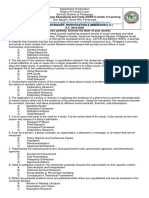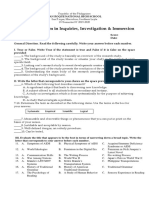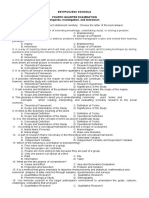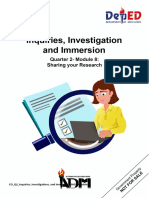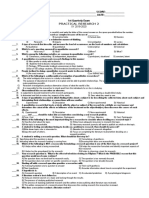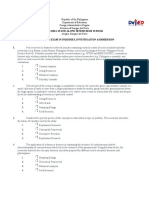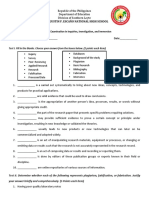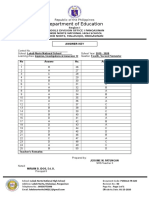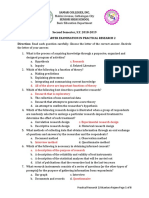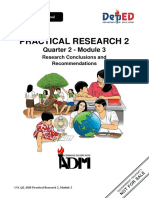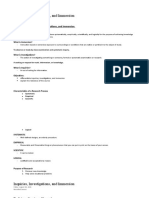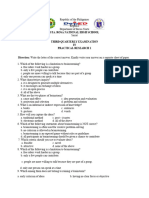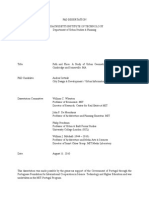Professional Documents
Culture Documents
First Quarterly Exam in Inquiries, Investigation and Immersion
First Quarterly Exam in Inquiries, Investigation and Immersion
Uploaded by
LUCIENNE S. SOMORAY0 ratings0% found this document useful (0 votes)
2K views3 pagesThis document appears to be an exam from Perrelos National High School testing students' knowledge of concepts related to inquiry, investigation, and immersion. The multiple choice exam contains 32 questions testing definitions and understanding of key research terminology and processes such as brainstorming techniques, developing operational definitions, reviewing related literature, research design types including descriptive and experimental, and data collection methods like questionnaires, interviews, and observation.
Original Description:
Copyright
© © All Rights Reserved
Available Formats
DOCX, PDF, TXT or read online from Scribd
Share this document
Did you find this document useful?
Is this content inappropriate?
Report this DocumentThis document appears to be an exam from Perrelos National High School testing students' knowledge of concepts related to inquiry, investigation, and immersion. The multiple choice exam contains 32 questions testing definitions and understanding of key research terminology and processes such as brainstorming techniques, developing operational definitions, reviewing related literature, research design types including descriptive and experimental, and data collection methods like questionnaires, interviews, and observation.
Copyright:
© All Rights Reserved
Available Formats
Download as DOCX, PDF, TXT or read online from Scribd
Download as docx, pdf, or txt
0 ratings0% found this document useful (0 votes)
2K views3 pagesFirst Quarterly Exam in Inquiries, Investigation and Immersion
First Quarterly Exam in Inquiries, Investigation and Immersion
Uploaded by
LUCIENNE S. SOMORAYThis document appears to be an exam from Perrelos National High School testing students' knowledge of concepts related to inquiry, investigation, and immersion. The multiple choice exam contains 32 questions testing definitions and understanding of key research terminology and processes such as brainstorming techniques, developing operational definitions, reviewing related literature, research design types including descriptive and experimental, and data collection methods like questionnaires, interviews, and observation.
Copyright:
© All Rights Reserved
Available Formats
Download as DOCX, PDF, TXT or read online from Scribd
Download as docx, pdf, or txt
You are on page 1of 3
Department of Education
Division of Carcar City
PERRELOS NATIONAL HIGH SCHOOL
First Quarter Exam in Inquiries, Investigation and Immersio n
Name: _______________________________ Grade & Section: ________________ Score: _________
Multiple Choice. Write the letter of the correct answer on a separate sheet of paper.
1. What is an informal or indirect expression of knowledge?
a. books b. gestures c. sentences d. words
2. What characterizes inquiry?
a. it is designed to generate multiple alternatives b. it encourages an exchange of ideas
c. it is an open process absorption d. all of the above
3. Which of the following are benefits of brainstorming when compared to nominal group technique?
a. brainstorming is more fun
b. brainstorming can generate a positive organizational climate
c. brainstorming can inspire talented and highly skilled employees to remain in an organization
d. all of the above
4. Which of the following statements about brainstorming is NOT correct?
a. brainstorming is often used for creative problem-solving
b. No criticism is allowed in brainstorming
c. Brainstorming is a vulnerable game without rules or guidelines
d. All participants in brainstorming should be given a chance to contribute to the process
5. Which of the following is a limitation to brainstorming?
a. free riders work harder in a group
b. only a few people can contribute
c. People are more willing to talk because they are part of a group
d. only one person can speak at a time
6. How many people should there be in a brainstorm?
a. 1-2 b. 3 c. 4-5 d. 6-10
7. What are the two phases of brainstorm?
a. cause and effect c. idea generation and evaluation
b. projection and selection d. problem and solution
8. What is the method used to capture ideas?
a. traditional method c. post – it notes
b. electronic method d. all of the above
9. Which criteria should you use to evaluate ideas?
a. feasible b. attractive c. novel d. none of the above
10.Which among does not belong to ruin a brainstorm?
a. early criticism of ideas b. having no clear focus or objective
c. need evaluation d. settling for too few ideas
11. The part of your study that will provide context to the information discussed throughout the research
process.
a. Background of the Study b. Scope and delimitation of the study
c. Operational Definition d. Significance of the study
12. It is considered as dictionary terminologies?
a. Operational Definition b. Conceptual Definition
c. Operational-Conceptual Definition d. All of the above
13. It is the meaning of the concept or terms as used in a particular study.
a. Conceptual Definition b. Conceptual Definition-Operational
c. Operational Definition d. All of the above
14.. The part of your study that sets boundaries and parameters of the problem inquiry and narrows down the scope
of the inquiry.
a. Theoretical and Conceptual Framework b. Background of the Study
c. Scope and delimitation of the study d. Scope and delimitation of the study
15. It will provide information to the reader on how the study will contribute.
a. Significance of the study b. Scope and delimitation of the study
c. Operational Definition d. Significance of the study
16. The part of your study is intended to assist you in understanding commonly used terms and concepts when
reading, interpreting, and evaluating scholarly research in the social sciences.
a. Background of the Study b. Scope and delimitation of the study
c. Glossary of Research Terms d. Significance of the Study
17. It is a chapter of your research paper wherein it is focused on giving an overview of all the writings relative to
your specific topics.
a. Introduction b. Review of Related Literature c. Methodology d. Results and Discussion
18. It is a source of information that is categorized by printed publications or writings wherein a researcher reports
the results of his studies.
a. Primary Source b. Secondary Source c. Tertiary Source d. General references
19. It is defined as a means of informing your readers that a certain piece of information came from a specific source
and you just borrowed it to widen the explanation of a certain situation or data of your research.
a. Literature b. Review c. Citations d. Sources
20. It is a manner of citation that commonly refers to all of the citations that are found in all of the chapters in the
research paper.
a. In-text citation b. Out-text citation c. Bibliography d. Referencing List
21. It is the guideline that is used in making synthesis.
a. Synthesis guide b. Synthesis Chart c. Synthesis matrix d. Synthesis graph
22.This is defined as the norms for conduct that distinguish between acceptable and unacceptable behaviors.
a. Attitude b. Ethics c. Humor d. Behavior
23. A plan on how the study will be conducted.
a. Research Plan b. Descriptive Design c. Experimental Design d. Research Design
24. Which design of research would evaluate effects, look into the cause and effect, and relationship or difference
between or among factors?
a. Research Plan b. Descriptive Design c. Experimental Design d. Research Design
25. Gathers information about the present existing conditions, that finds the answer to questions who, what, when,
where, and how.
a. Research Plan b. Descriptive Design c. Experimental Design d. Research Design
26. A process or record of research in which detailed consideration is given to the development of a particular
person, group, or situation over a while.
a. Feasibility Study b. Case Study c. Content Analysis d. Problem-Solving
27 Homogenous strata, ensure representative proportions, wherein the researcher includes the specified number of
samples like 5 samples only.
a. Convenience Sampling b. Quota Sampling c. Purposive Sampling d. Snowball Sampling
28.Sampling method that is handpicked by the researcher based on qualities for purposes of study.
a. Convenience Sampling b. Quota Sampling c. Purposive Sampling d. Snowball Sampling
29.The questionnaire is to the data-collection instrument; observation is to datacollection _________.
a. Method b. Process c. Analysis d. Results
30.A self-directing instrument structured with questions and indicators.
a. Questionnaire b. Interview c. Observation d. Instrument
31.A conversation where questions are asked and answers are given.
a. Questionnaire b. Interview c. Observation d. Instrument
32.The process of observing something or someone to gain information.
a. Questionnaire b. Interview c. Observation d. Instrument
Page 2 III Q1
You might also like
- RepetMat Arkusz Podst 1Document15 pagesRepetMat Arkusz Podst 1Anita BuryNo ratings yet
- Inquiries, Investigation and Work Immersion: Dr. Panfilo Castro National High School - Masalukot I AnnexDocument3 pagesInquiries, Investigation and Work Immersion: Dr. Panfilo Castro National High School - Masalukot I AnnexArnold Pancho94% (18)
- Diagnostic Test Practical Research 2Document4 pagesDiagnostic Test Practical Research 2Lubeth Cabatu88% (8)
- CHCECE038 Assessment Task 2 Placement 2 Observation v2Document10 pagesCHCECE038 Assessment Task 2 Placement 2 Observation v2Sherin SubhanNo ratings yet
- MID-term Test On Inquiries, Investigations, and ImmersionDocument5 pagesMID-term Test On Inquiries, Investigations, and ImmersionNeil Jasper B. Ducut100% (7)
- 3rd Periodical - Inquiries, Investigation & ImmersionDocument4 pages3rd Periodical - Inquiries, Investigation & ImmersionRi El85% (13)
- Third Periodical Test in Prac Research 1Document2 pagesThird Periodical Test in Prac Research 1Ram Kuizon80% (5)
- 4 Inquiries Investigation and ImmersionDocument3 pages4 Inquiries Investigation and ImmersionCharlie Rivera100% (1)
- 4Th Quarter: Summative Test in Practical Research 1Document4 pages4Th Quarter: Summative Test in Practical Research 1Mary Grace Goron100% (1)
- Summative Exam 4 Sets Inquiry, Investigation and ImmersionDocument7 pagesSummative Exam 4 Sets Inquiry, Investigation and ImmersionAruel Delim100% (4)
- Practical Research 2 First Quarter Assessment PDF FreeDocument8 pagesPractical Research 2 First Quarter Assessment PDF FreeRosario OcamiaNo ratings yet
- CO - Q2 - Inquiries, Investigations, and Immersion (SHS) - Module8Document30 pagesCO - Q2 - Inquiries, Investigations, and Immersion (SHS) - Module8Emily Tabamo100% (3)
- Practical Research 2 SummativeDocument5 pagesPractical Research 2 SummativeColeen Mae Saluib100% (5)
- Practical Research 2 1st Sem 1stquarterdocxDocument5 pagesPractical Research 2 1st Sem 1stquarterdocxArianne Novo100% (3)
- Alegria Stand Alone Senior High SchoolDocument5 pagesAlegria Stand Alone Senior High SchoolJAKE FRANCIS LUMBRES100% (2)
- 1st Summative Test in Practical Research 2: Am I Quantitative or Qualitative?Document2 pages1st Summative Test in Practical Research 2: Am I Quantitative or Qualitative?Angela Miranda Diwa100% (4)
- Midterm Exam in 3i'sDocument5 pagesMidterm Exam in 3i'sMary Grace Jerna Artazo Nozal-Cuadra100% (1)
- First-Quarter-Exam PRACTICALDocument21 pagesFirst-Quarter-Exam PRACTICALMarina AbanNo ratings yet
- Inquiries Midterm ExamDocument2 pagesInquiries Midterm ExamMarkmarilyn100% (2)
- 3rd Quarter Examination in 3isDocument2 pages3rd Quarter Examination in 3iseliana tm31100% (2)
- Long Quiz in Inquiry, Investigation and ImmersionDocument2 pagesLong Quiz in Inquiry, Investigation and ImmersionDiana San Diego80% (5)
- Practical Research 2 TestDocument4 pagesPractical Research 2 TestLen MayNo ratings yet
- Research 2 First Quarter ExamDocument5 pagesResearch 2 First Quarter ExamHazel Escobio Justol Cahucom100% (3)
- PRACTICAL RESEARCH 2 - 1ST QUARTER (Students' Copy)Document5 pagesPRACTICAL RESEARCH 2 - 1ST QUARTER (Students' Copy)Zen CandiaNo ratings yet
- Midterm Exam PR2Document6 pagesMidterm Exam PR2Prince Reinier Jon0% (1)
- Pretest pr1Document2 pagesPretest pr1Dolores Mayuga PanchoNo ratings yet
- Learner'S Activity Sheet Grade12 - Inquiries, Investigations, and ImmersionsDocument4 pagesLearner'S Activity Sheet Grade12 - Inquiries, Investigations, and ImmersionsMlyn50% (2)
- 1st Quarterly Exam On Practical Research 2Document3 pages1st Quarterly Exam On Practical Research 2Domingo Estola83% (6)
- Final Exam 3i'sDocument4 pagesFinal Exam 3i'sMary Grace Jerna Artazo Nozal-Cuadra100% (1)
- PR 2 ExamDocument2 pagesPR 2 ExamAbegail Panang75% (4)
- Long Quiz 3iDocument2 pagesLong Quiz 3iNica Joyce AquinoNo ratings yet
- 4th Quarter Answer Key For Inquiries, Investigations and Immersion 12Document1 page4th Quarter Answer Key For Inquiries, Investigations and Immersion 12Jerome Macasieb Patungan64% (25)
- Second Quarter Exam Inquiries, Investigation and ImmersionDocument5 pagesSecond Quarter Exam Inquiries, Investigation and ImmersionLUCIENNE S. SOMORAY100% (1)
- Midterm Exam For Prac Res 2 PDFDocument5 pagesMidterm Exam For Prac Res 2 PDFSarah Jane Manigbas100% (1)
- Exam in Inquiries, Investigastions and ImmersionDocument2 pagesExam in Inquiries, Investigastions and ImmersionMary Ann Tuazon100% (2)
- Practical Research 2 QuizDocument2 pagesPractical Research 2 QuizPepito Manloloko67% (9)
- Diagnostic Test Research 2Document3 pagesDiagnostic Test Research 2Lubeth CabatuNo ratings yet
- Inquiries Prelim ExamDocument3 pagesInquiries Prelim ExamMarkmarilynNo ratings yet
- Practical Research Second Quarter ExamDocument8 pagesPractical Research Second Quarter ExamRAZEL ALCANTARA100% (4)
- Arellano University Andres Bonifacio Campus Practical Research 2 Diagnostic TestDocument2 pagesArellano University Andres Bonifacio Campus Practical Research 2 Diagnostic TestFATIMANo ratings yet
- Practical Research 2 Summative TestDocument5 pagesPractical Research 2 Summative TestLarrySultiz80% (10)
- 3RD QUARTER EXAMINATION ResearchDocument4 pages3RD QUARTER EXAMINATION ResearchMaria Erika Glenda Beltran50% (2)
- Inquiries, Investigation and Immersion: Quarter 2 - Module 4: Presentation of Research ReportDocument25 pagesInquiries, Investigation and Immersion: Quarter 2 - Module 4: Presentation of Research ReportJohn Robert Binarao DetuyaNo ratings yet
- 3is Quarter-3-Exam-2020-2021Document4 pages3is Quarter-3-Exam-2020-2021kate lim100% (1)
- Prac 1 BDocument5 pagesPrac 1 BRam KuizonNo ratings yet
- Practical Research 2 - 2nd QuarterDocument2 pagesPractical Research 2 - 2nd QuarterJohn Rey Cantoria100% (1)
- PracResearch2 Grade-12 Q2 Mod3 Research-Conclusions-And-Recommendations CO Version 2Document28 pagesPracResearch2 Grade-12 Q2 Mod3 Research-Conclusions-And-Recommendations CO Version 2Hector Panti100% (1)
- PRACTICAL RESEARCH 2 - TQ (1st Quarter 2023)Document5 pagesPRACTICAL RESEARCH 2 - TQ (1st Quarter 2023)Louie Jane Eleccion100% (3)
- 2.module - PR 2 (Day 3 & 4 of Week 6) - Defining TermsDocument29 pages2.module - PR 2 (Day 3 & 4 of Week 6) - Defining TermsKevz Becerro Espiel100% (1)
- Aquinas de Escolar Academy: Midterm Examination Practical Research Ii-12Document2 pagesAquinas de Escolar Academy: Midterm Examination Practical Research Ii-12Alyssa Gonzales75% (4)
- Diagnostic Test in PR2Document2 pagesDiagnostic Test in PR2Vanessa Tamayo, Ph. D100% (2)
- 1st Quarter Exam For 2nd Semester - Practical Research 1Document4 pages1st Quarter Exam For 2nd Semester - Practical Research 1Graciously Elle0% (1)
- Inquiries, Investigations, and ImmersionDocument26 pagesInquiries, Investigations, and ImmersionJhon Keneth Namias100% (7)
- Fourth Quarter Examinations in 3IDocument7 pagesFourth Quarter Examinations in 3Ironaliza c. cerdenola100% (1)
- Summative Test PR 1 Quarter 1Document3 pagesSummative Test PR 1 Quarter 1Arnold PanchoNo ratings yet
- Third Grading-3i's Summative TestDocument11 pagesThird Grading-3i's Summative TestArlynne Joy BuctilNo ratings yet
- Module For GA 3i.sDocument8 pagesModule For GA 3i.slacanajessamae18No ratings yet
- Iii Summative Test 12Document6 pagesIii Summative Test 12Kiella SultanNo ratings yet
- 3rd Quarter Pr1Document6 pages3rd Quarter Pr1Julia Lorraine DocusinNo ratings yet
- Department of Education: Republic of The Philippines Kaligtasan National High SchoolDocument4 pagesDepartment of Education: Republic of The Philippines Kaligtasan National High SchoolMabhelOnteIbabaoNo ratings yet
- Reviewer in PR 2Document11 pagesReviewer in PR 2Ciara ManangoNo ratings yet
- 3is ReviewerDocument5 pages3is ReviewerGwen LopezNo ratings yet
- English 10 - 4th Quarter - Module 3 - v.01 CC Released 4june2021Document19 pagesEnglish 10 - 4th Quarter - Module 3 - v.01 CC Released 4june2021LUCIENNE S. SOMORAYNo ratings yet
- English 10 - 4th Quarter - Module 2 - v.01 CC Released 22may2021Document19 pagesEnglish 10 - 4th Quarter - Module 2 - v.01 CC Released 22may2021LUCIENNE S. SOMORAYNo ratings yet
- English 10 - 4th Quarter - Module 1 - v.01 CC Released 19may2021Document20 pagesEnglish 10 - 4th Quarter - Module 1 - v.01 CC Released 19may2021LUCIENNE S. SOMORAYNo ratings yet
- English 10 - 4th Quarter - Module 5 - v.01 CC Released 21june2021Document23 pagesEnglish 10 - 4th Quarter - Module 5 - v.01 CC Released 21june2021LUCIENNE S. SOMORAYNo ratings yet
- Second Quarter Exam Inquiries, Investigation and ImmersionDocument5 pagesSecond Quarter Exam Inquiries, Investigation and ImmersionLUCIENNE S. SOMORAY100% (1)
- MEDIA AND INFORMATION 1st Quarterly AssessmentDocument4 pagesMEDIA AND INFORMATION 1st Quarterly AssessmentLUCIENNE S. SOMORAYNo ratings yet
- MIL 2nd Quarterly Exam - 2023Document5 pagesMIL 2nd Quarterly Exam - 2023LUCIENNE S. SOMORAY100% (1)
- All PortDocument18 pagesAll Portrufino.perea.1000No ratings yet
- Republic of The Philippines Office of The President Commission On Higher EducationDocument16 pagesRepublic of The Philippines Office of The President Commission On Higher EducationAbiekhay Camillee Unson LavastidaNo ratings yet
- Andres Sevtsuk PHDDocument225 pagesAndres Sevtsuk PHDNegar SBNo ratings yet
- Mt. Carmel School of Siargao, IncDocument4 pagesMt. Carmel School of Siargao, IncJoseph Gil Rosaban Bandoy100% (1)
- Portfolio Checklist and Self-AssessmentDocument14 pagesPortfolio Checklist and Self-AssessmentRaynard MaestradoNo ratings yet
- SCHEFF, Thomas. The Distancing of Emotion in RitualDocument24 pagesSCHEFF, Thomas. The Distancing of Emotion in RitualBruna BaceleteNo ratings yet
- The Representation of The Concept of Inf PDFDocument152 pagesThe Representation of The Concept of Inf PDFSimon ChiewNo ratings yet
- Inclusive Leadership and Work Engagement: Mediating Roles of Affective Organizational Commitment and CreativityDocument13 pagesInclusive Leadership and Work Engagement: Mediating Roles of Affective Organizational Commitment and CreativityAmbreen ZainebNo ratings yet
- Syllabus Geopolitics and Environment CourseDocument10 pagesSyllabus Geopolitics and Environment CourseLaudith OrtegaNo ratings yet
- 7 Main Factors Which Affect The Social Change in Every SocietyDocument9 pages7 Main Factors Which Affect The Social Change in Every Societysamuel villaNo ratings yet
- Surat City - PUT22469 - SONALIDocument14 pagesSurat City - PUT22469 - SONALISonali HarlalkaNo ratings yet
- Dwnload Full Recruitment and Selection in Canada Canadian 5th Edition Catano Solutions Manual PDFDocument36 pagesDwnload Full Recruitment and Selection in Canada Canadian 5th Edition Catano Solutions Manual PDFchaburnsymvh100% (13)
- Đề thi thử vào 10 chuyên Anh số 10Document12 pagesĐề thi thử vào 10 chuyên Anh số 10Phạm Đức DuyNo ratings yet
- HUM1 - Modules 1 3 Pineda FINALDocument36 pagesHUM1 - Modules 1 3 Pineda FINALKen ManalaysayNo ratings yet
- Recommendation L1 2Document2 pagesRecommendation L1 2sabit hussenNo ratings yet
- Kubik Ethnography of PoliticsDocument15 pagesKubik Ethnography of PoliticsgustavoNo ratings yet
- The Impacts of Employee Workplace Empowerment, Effective Commitment and Performance: An Organizational Systematic ReviewDocument23 pagesThe Impacts of Employee Workplace Empowerment, Effective Commitment and Performance: An Organizational Systematic ReviewInternational Journal of Innovative Science and Research TechnologyNo ratings yet
- Hbo Chapter 8Document29 pagesHbo Chapter 8Virginia MendozaNo ratings yet
- Nonverbal Communication in The WorkplaceDocument13 pagesNonverbal Communication in The WorkplaceAmdcNo ratings yet
- PDF Contemporary Perspectives On The Freudian Death Drive in Theory Clinical Practice and Culture Victor Bluml Ebook Full ChapterDocument53 pagesPDF Contemporary Perspectives On The Freudian Death Drive in Theory Clinical Practice and Culture Victor Bluml Ebook Full Chapterjuan.pinney241100% (4)
- 1 s2.0 S2590291123003674 MainDocument9 pages1 s2.0 S2590291123003674 MainZikri AhmadNo ratings yet
- Ethics Module Template AY 22 23Document51 pagesEthics Module Template AY 22 23Edison Lucidos Jr.No ratings yet
- Ode Melancholy Imagery ActivityDocument8 pagesOde Melancholy Imagery ActivityLisa Mary Bejoy100% (1)
- Adjunto A La Comunidad. INGLÉSDocument2 pagesAdjunto A La Comunidad. INGLÉSMarco Santelices WNo ratings yet
- Interpretative Phenomenological Analysis Theory IkhtisarDocument8 pagesInterpretative Phenomenological Analysis Theory IkhtisarFadliNo ratings yet
- Preliminary Pages 1Document10 pagesPreliminary Pages 1Jheanelle CabreraNo ratings yet
- Schedule-of-Exam-III-IX - XI - Annual - 2024 SunbeamDocument2 pagesSchedule-of-Exam-III-IX - XI - Annual - 2024 SunbeamLokesh sai sri rajNo ratings yet
- Adolescent Growth and DevelopmentDocument25 pagesAdolescent Growth and Developmentmarjorie lopezNo ratings yet




